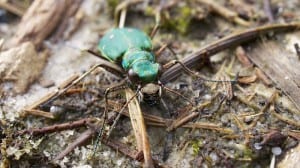Specimen of the Week: Week 139
By Dean W Veall, on 9 June 2014
Dean Veall here. This week it’s me that is bringing to your attention one specimen from the 68,000 we have in the Museum. When faced with the choice I was bereft, 68,THOUSAND specimens, spoilt for choice is a better way to think about it. With that in mind I knew I was keen to advance the agenda set out by Mark to address the big and furry vertebrate imbalance (nb. not all vertebrates are either big or furry) . So, my specimen is drawn from one of our invertebrate cases. My specimen also had to be something that has contributed to the ‘Story of Dean Veall‘ . So here it is but, a word of caution, this week’s tale involves mild peril, articulated lorries and temporary blindness. Intrigued, well dear reader, read on, read on. This week’s Specimen of the Week is…
**The green tiger beetle**
1) Tiger beetles are AWESOME!! They are the top predatory insect here in the UK. If you are a ground dwelling invertebrate, a caterpillar or an ant then look out – you are definitely in the sights of the green tiger beetle (Cicindela campestris). These ferocious predators have some key adaptations that I think deserve them a place on the Deadly 60 list (we’ve just finished our half term activities and I’ve had hundreds of discussions with our younger visitors about Deadly 60), so if you are reading Steve Backshall, get on the green tiger beetle bandwagon. One prime reason for their awesomeness are their mandibles, they are huge and sickle shape helps them catch and hold onto their prey. Once in their grip they coat their prey in a fluid of pre-digestive enzymes that is secreted from the base of each mandible. The prey is then racked into the mouth cavity to be masticated further into a delicious puree of insect (Pearson, 2001). The larvae of this species are also killing machines and develop in burrows in the ground. These serve to act like their very own pitfall trap, where unsuspecting prey will fall to their delicious doom, a bit like the Sarlacc monster from that film, Star Wars Episode VI: Return of the Jedi.
2) More like a green cheetah beetle. This may be a more appropriate name for this beetle given a piece of research that was published back in February this year by
entomologists at Cornell University. Tiger beetles can reach speeds of up to 5 miles per hour and can cover up to 120 body lengths per second, that is one fast beetle. Hunting at such speeds makes the tiger beetles go ‘blind’ according to the research from Cornell, resulting in them not being able to see where they are going. It appears that these beetles have evolved a mechano-sensing behaviour to overcome the problem of not being able to capture enough light from their prey when traveling at such speeds by holding their antennae out rigidly in front of them to mechanically sense their environment (Zurek, 2014). Check out the video here.
3) Tiger beetles do not live on roundabouts in Bracknell. Imagine the thrill of finding one of these beautiful beetles in the bottom of your pitfall trap, oh the wide eyed excitement! I spent three months back in 2006 waiting with baited breath as I emptied my traps every other day. Would today be the day that I would find a green tiger beetle? My final year undergraduate project involved studying the insect, notablybeetle, diversity of roundabouts of Bracknell. Why roundabouts and why Bracknell I hear you ponder. Well, roundabouts are a brilliant model to understand island biogeography (Helden, 2004), the idea the the bigger an island is
the more diverse the animals and plants that are found on them. Roundabouts are just like islands of varying sizes , some small planted with turf and ornamental flowers so huge and wild with mature trees. My tutor at the time was the brilliant Simon Leather who’s passion about insects inspired me to run across the dual carriageways of Bracknell to find reach the many many roundabouts that are dotted over the town. My Summer dodging articulated lorries was such a brilliant introduction into the world of entomology. I discovered a plethora of different Coleoptera species, the violet ground beetle was a particular favourite, but the green tiger beetle was the one that got away, the one that eluded me, so tiger beetles are not found on the roundabouts of Bracknell, in my experience.
4) Towns and cities are rife with wildlife. From beetles on roundabouts to salmon in the Thames to otters in Bristol, our cities are becoming home to some fantastic wildlife again. Simon Leather has written about the opportunities that proper management of green spaces that involves cutting regimes of places such as roundabouts and gardens can help turn them into havens for nature. His blog Don’t forget about the roundabouts is one to read if you are interested. And if you are hunting for green tiger beetles, head to some disused open grounds (brownfield sites) in cities, the bare soil are the favoured habitat of this species when they are in town. Closer to home we are doing research on urban ecology here at UCL. Alison Fairbrass recently shared her research with us in her Show’n’Tell event capturing wildlife sounds to help understand the value of green spaces in cities. So it would seem that it’s increasingly more than just pigeons and rats we share our city with.
5) Ode to Cicindela campestris. How many beetles do you know have a piece of classical music named after them? The green tiger beetle may well be the first member of the group of insects known as the Coleoptera to have inspired an ode. Composer Stephen Andrew Rawle was so taken by these beetles that he created Opus 43, Cicindela Campestris, for clarinet, violin and piano. I personally haven’t been able to find it so if anyone does then please send us over a link.
References
Helden, A. J. & Leather, S. R. (2004). Biodiversity on urban roundabouts – Hemiptera, management and the species-area relationship. Basic and Applied Ecology 5: 367-377
Pearsons, D.L. and Volger, A.P. (2001) Tiger Beetles: The Evolution, Ecology, and Diversity of the Cicindelids
Zurek, D.B. and Gilber, C. (2014) Static antennae act as locomotory guides that compensate for visual motion blur in a diurnal, keen-eyed predator, Proc R Soc B 281: 20133072.
Dean Veall is Learning Officer at the Grant Museum of Zoology
One Response to “Specimen of the Week: Week 139”
- 1
 Close
Close






Great post Dean
and we never did find any Tiger beetles on the roundabouts despite having a PhD student spend three years trapping on them after you finished
Simon